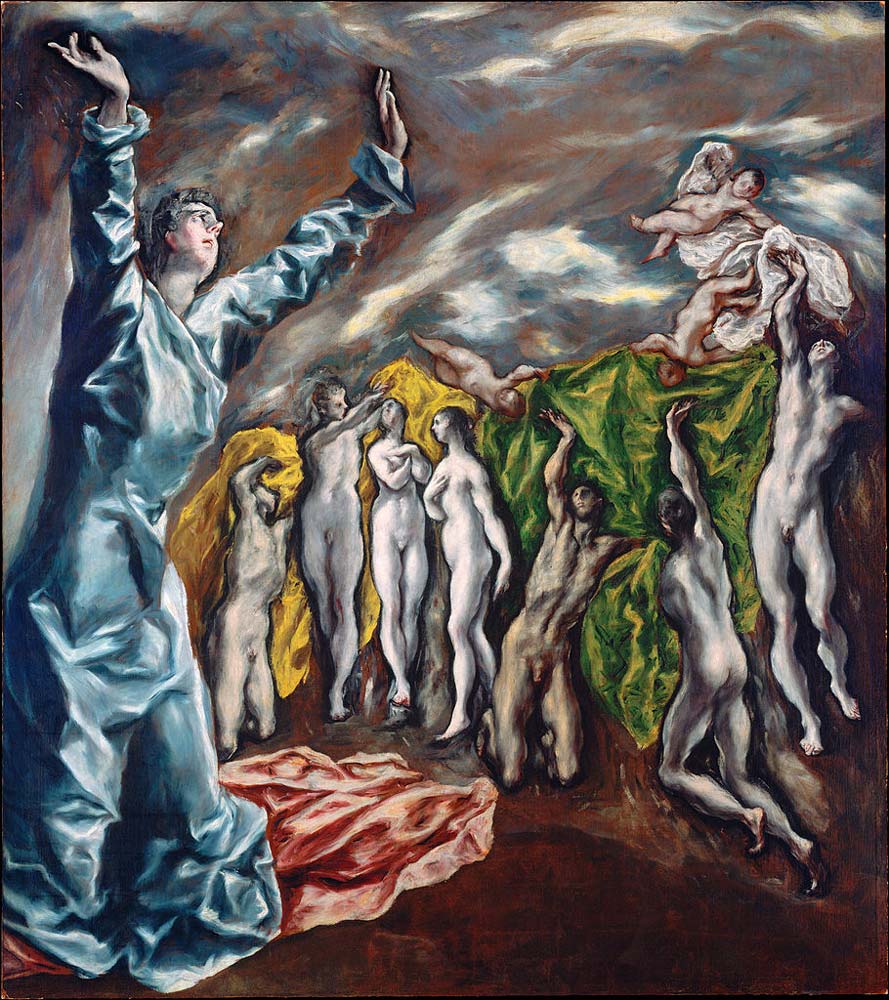| Opening of the Fifth Seal | |
|---|---|
 |
|
| Artist | El Greco |
| Year | 1608–1614 |
| Medium | Oil on canvas |
| Location | The Metropolitan Museum of Art, New York City |
| Dimensions | 88.5 in × 78.5 in |
| 224.8 cm × 199.4 cm | |
| Famous Paintings by El Greco | |
| The Disrobing of Christ, 1577–1579 | |
| Opening of the Fifth Seal, 1608-1614 | |
| Dormition of the Virgin, 1565-1566 | |
| The Burial of the Count of Orgaz, 1586 | |
| View of Toledo, 1596-1600 | |
| The Adoration of the Shepherds, 1612–14 | |
| Christ Healing the Blind, c. 1570 | |
| The Entombment of Christ, c.1570 | |
| St. Martin and the Beggar, 1597-1599 | |
| Complete Works |
The Opening of the Fifth Seal by El Greco was painted during the last years of the artist’s life. This famous masterpiece was also referred to as The Vision of Saint John or the Fifth Seal of the Apocalypse. It was intended to be displayed at the side altar of Saint John the Baptist Church, which was located outside Toledo. Before the year 1908, this exquisite painting by El Greco was called Profane Love. However, there were doubts about the actual title of the painting, so Cossio suggested the title Opening of the Fifth Seal. At present, the artwork is featured at the Metropolitan Museum, and critics express their thoughts about the painting that it appears abraded and quite damaged.
Subject and Theme
The theme of the painting is based from the Book of Revelation. It depicts the souls of all martyrs that are persecuted, and they plea for God’s justice upon the salvation of their persecutor’s on earth. The Opening of the Fifth Seal also features the ecstatic image of Saint John, as he dominates the entire canvas. Behind this figure are naked souls that are filled with an intense gush of emotion, as they are rewarded with the white robes of glory and salvation from God.
The upper section of the painting appears to be cut down, as it was destroyed during the 1880s. However, the lower part seems to resemble another altar piece by El Greco, which was entitled The Concert of Angels. This masterpiece was also intended to be placed on the same church, although the painting was cut off, as well. Most critics believe that the preserved part of the painting showed profane love, while the missing portion of the artwork depicted divine love.
Additional Facts
During the 19th century, the artwork was owned by Antonio del Castillo, who was Spain’s Prime Minister. Unfortunately, he was dissatisfied by the painting’s poor condition, so he ordered it to be restored in the 1880s. Those who restored the painting trimmed it by about 175 centimeters, and it left John the Evangelist oddly pointing nowhere. With this strange appearance of the painting, several critics were intrigued about the artwork, which contributed to the fame of the masterpiece among the modernist circles.
Eventually, the painting was sold to Ignacio Zuloaga, who was a painter that revived European interest in El Greco’s work. Moreover, the Opening of the Fifth Seal has become evident in the background of Zuloaga’s painting Mis Amigos, which represented several members of the renowned Generation of ’98. Zuloaga declared that El Greco’s masterpiece possessed a certain visionary power, which made it a precursor to modern art. Then, the Zuloaga Museum sold the artwork to New York City’s Metropolitan Museum of Art, where the painting is presently displayed.
The painting, which was unfinished, was listed in the postmortem inventory. It depicts a particular passage in the Revelation that described the Opening of the Fifth Seal. Although there was a missing part in the upper portion of the artwork, it remains to be one of the finest works made throughout history.